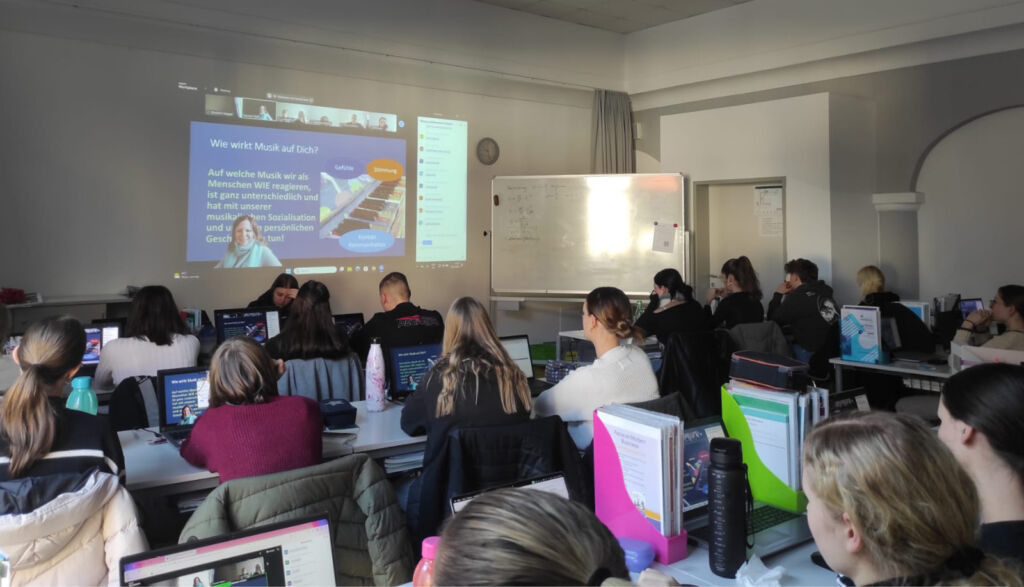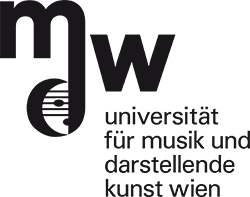mdw Researchers as Ambassadors of Scholarship and Science
How do kids and teens learn about what’s being researched at universities? And where can the findings of scientists and scholars be directly perceived in our everyday lives? Science communication formats aim to enable people situated outside of academic fields to encounter topics from the realm of science and research in the most accessible way possible.

Hannah Riedl, a music therapist, mdw senior scientist, and teaching faculty member at the Department of Music Therapy; Malte Kob, a professor of vocal research at the Antonio Salieri Department of Vocal Studies and Vocal Research in Music Education; and Anna Wukovits-Zethner, responsible for science communication at the mdw’s Office of Research Support, speak here about science communication’s opportunities and challenges.
Ms. Riedl, Mr. Kob: you’re both active as Research Ambassadors. Under the aegis of Austria’s Agency for Education and Internationalisation (OeAD), you hold workshops at schools that introduce their students to your research fields and professions. How do you go about that, and what have your experiences been like?
Hannah Riedl (HR): I usually start by asking school students what they think of when they hear the term “music therapy”, and it was once the case that a student asked me whether music therapy was for blind people. So picking up on however students might respond, I then go on to tell them about the areas where music therapy is used and how it all plays out. Older students often have an easier time associating things with various forms of therapy based on experiences of their own or of people they know. And with those students, discussions also tend to include questions about music therapy as a profession, what positions there are, and how the pay is.
Malte Kob (MK): I offer one workshop on room acoustics and another on the physics of the singing voice. To introduce room acoustics, I first ask: What do you notice about this classroom when you clap your hands and shout? And what’s different when you do the same thing in a space with an echo, like in a corridor? This clues them into how different spaces react. And starting from their impressions, we then begin a dialogue on the foundations of room acoustics. In the workshop on the singing voice, on the other hand, I use my own voice to present them with examples. That helps me come across as a researcher who’s approachable.
Why are things like the Research Ambassadors programme important, and what can researchers learn from it?
Anna Wukovits-Zethner (AWZ): With our workshops adapted to different age levels, we reach children and teenagers including ones who aren’t from families where there’s an interest in science or scholarship. School students become aware of science and scholarship and develop an interest in them when they’re shown things like how a field of research is present in their own lives. It’s encouraging to them when others acknowledge their ability to engage with topics that are researched at universities. Moreover, the participating researchers can offer them a more realistic impression of academic work by presenting themselves as human beings with strengths and weaknesses. That kind of communication on an equal footing as well as recognising multiple different forms of knowledge are central approaches in science communication.
HR: When you work in an academic field, one of the foremost things you learn is how to use specialised language when engaging in exchange with colleagues from the academic community. Science communication formats, on the other hand, provide researchers with a fantastic opportunity to learn and practice how to explain their work in simple language and in ways that relate to people’s respective life realities. I think that’s essential, including for one’s own university-level teaching.
MK: Children and teenagers give me very direct reactions to my questions. And with their widely varied backgrounds, school students end up contributing all kinds of ideas and questions to our dialogue—to which I, as a researcher, then have to react. That’s unbelievably good training for me, because it requires improvisation and is so different from how a university lesson runs. And on the kids’ end, this kind of discourse can get them interested in pursuing academic work later on.
How do things look in terms of science communication oriented toward adults? And how do you view the oft-discussed scepticism toward science that exists out there?
AWZ: If a person doesn’t acknowledge that researchers create knowledge and that there are well-founded methods by which to do so, you’ll hardly be able to change that person’s mind—which is why it’s important to begin as early as possible in schools. Children and teenagers are potential multipliers and can also have an effect on their families. The Long Night of Research1 and the Vienna Research Festival, where 2025 saw music therapy represented for the first time, are conceived for people of all ages—and in such contexts, the mdw has the advantage of being able to present content of an artistic nature. There’s a huge potential there to reach a broad audience on an emotional level, and it goes well with our “third mission” goals as a university to involve target audiences outside of our own communities and provide them with access to the arts, culture, and the sciences.
MK: The Long Night of Research is a great opportunity to introduce new methods and show how these are applicable to present-day questions. And in order to reinforce this outreach, I could imagine even more collaboration with the areas of the mdw that train students as artists and as educators. Getting pure research across isn’t easy, but it’s very possible indeed when applied to questions of an artistic and/or pedagogical nature.
HR: Scepticism toward science is something I haven’t yet experienced in children or teenagers. I think every person has a desire to learn as well as an interest in some topic. I don’t accuse my young audience of scepticism; I assume their curiosity and/or attempt to spark it.
How is science communication developing at the mdw, and what kinds of developments would be desirable?
AWZ: The Office of Research Support has been implementing science communication measures for several years. Among our researchers, we’re now noticing greater willingness and motivation to participate actively and develop new skills. Since the mdw is home to lots of different disciplines, our goal is to create maximally individualised offerings such as further training workshops on things like creating up-to-date communication tools including podcasts and videos or organising art-science hubs. Another interesting approach would be greater involvement on the part of students.
HR: I think that learning more about science communication methods is a matter of adding methodological depth, much like what happens in a research project. An important thing is that researchers engage in exchange around science communication, building up relevant knowledge as a research community and showing mutual esteem for what their colleagues are doing. This type of activity should also be clearly desired by one’s own university; it has to count for something in researchers’ portfolios when they engage in science communication as part of their research activities.
mdw.ac.at/forschungsfoerderung/science-communication/
youngscience.oead.at/de/wissenschaftsvermittlung/wissenschaftsbotschafter-innen

